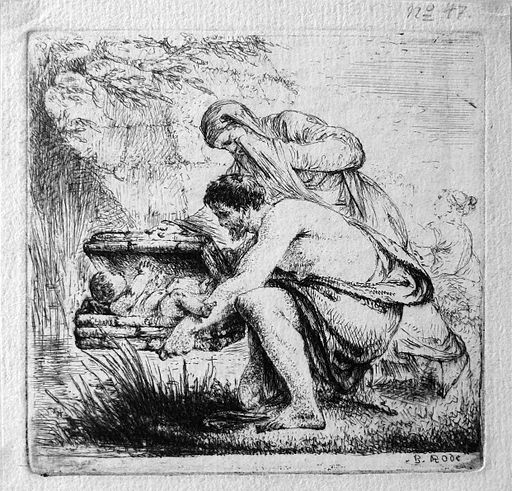by Gabriel Said Reynolds*

Moses Set Out on the Nile in a Reed Basket. Engraving by Bernhard Rode, ca. 1775; photo accessed via Wikimedia Commons.
Qurʾan 20:39 recalls how God instructed Moses’ mother to place her infant son in a tābūt and set him upon a river, that he might escape Pharaoh. In Modern Standard Arabic, tābūt can mean “box, case, chest, coffer” or “casket, coffin, sarcophagus,” and many translators render tābūt in the Qur’an in light of one or another of these meanings. Asad (“chest”), Hilali-Khan (“a box or a case or a chest”), Yusuf Ali (“chest”), Hamidullah (“coffret”), and Paret (“Kasten”) all choose the first meaning; Quli Qaraʾi (“casket”) chooses the second.
The awkward image of the infant Moses floating on the Nile in a casket illustrates the problem of understanding Qurʾanic terms in light of their meanings in Modern Standard Arabic. Not all translators do so. Pickthall and Arberry, among others, render tābūt, “ark.” This dramatically different translation presumably reflects the influence of Qurʾan 2:248, where the Qurʾan uses tābūt for the Ark of the Covenant.
In fact, Q 2:248 is the key to understanding tābūt in Q 20:39. Tābūt reflects the Hebrew term tebā (itself a borrowing from Egyptian), the term used for the basket in which Moses’ mother places him (Exodus 2:3; tebā evidently means “basket” here because it is made  out of reeds). Tebā is also used for the ark that Noah builds (Genesis 6:14, 15, passim). As Arthur Jeffery (Foreign Vocabulary, 88-89) notes, Qurʾanic tābūt is closer in form to Aramaic tībū (used in Targum Onkelos for both Noah’s ark and Moses’ basket) and even more so to Ethiopic tābot. The connection with Ethiopic tābot might be particularly important since it (like Syriac qebūtā) is used for Noah’s ark, Moses’ basket, and the Ark of the Covenant.
out of reeds). Tebā is also used for the ark that Noah builds (Genesis 6:14, 15, passim). As Arthur Jeffery (Foreign Vocabulary, 88-89) notes, Qurʾanic tābūt is closer in form to Aramaic tībū (used in Targum Onkelos for both Noah’s ark and Moses’ basket) and even more so to Ethiopic tābot. The connection with Ethiopic tābot might be particularly important since it (like Syriac qebūtā) is used for Noah’s ark, Moses’ basket, and the Ark of the Covenant.
In any case, my point here is not to make an argument about a particular etymology for tābūt but rather to illustrate the danger of relying on Modern Standard Arabic in our reading of the Qurʾan. The way in which the Qurʾan uses tābūt for both Moses’ basket (Q 20:39) and the Ark of the Covenant (Q 2:248) reflects the Biblical background of this term. Therefore, in Qurʾan 20:39, tābūt might be understood in light of this background to mean simply “basket” (even if this meaning is not found in Hans Wehr’s dictionary).
Tābūt is not the only example of the problem of Modern Standard Arabic understandings of the Qurʾan. Qur’an 3:44 alludes to the account of the contest between the widowers of Israel over Mary. In the version of this account in the (2nd century) Protoevangelium of James, all of the widows hand their staffs (as lots) to the priest Zechariah, in whose care Mary has been kept in the Jerusalem Temple. From the last staff, that of Joseph, a dove emerges, indicating that he is God’s choice. The term that the Qurʾan uses for these staffs is qalam (pl. aqlām), from Greek kalamos (“reed”). Yet qalam also came to mean “pen,” and indeed this is its common meaning in Modern Standard Arabic. Thus if one reads the Qurʾan in light of Modern Standard Arabic, Q 3:44 would seem to involve throwing pens around.
A final case, the term dīn, has theological consequences. As Mun’im Sirry points out in his recent work Scriptural Polemics: The Qurʾan and Other Religions (esp. 66-89), many modern commentators understand Qurʾanic occurrences of dīn to denote “religion,” and indeed translators almost always render dīn “religion” (for Q 3:19 I did not find any cases where it is translated otherwise). This has important consequences, especially with verses such as Q 3:19 and 85, which can be read to mean that Islam is the only acceptable religion. Yet in light of Semitic and non-Semitic cognates (such as Syriac dīnā), Qurʾanic dīn might have—in some instances at least—a more general meaning of “judgment” (hence the phrase yawm al-dīn). In other instances, dīn might mean something closer to religious disposition, rather than religion in the modern sense of a communal system of faith and worship. Accordingly, students of the Qurʾan should be wary of reading dīn, or any Qurʾanic term, through the lens of Modern Standard Arabic.
